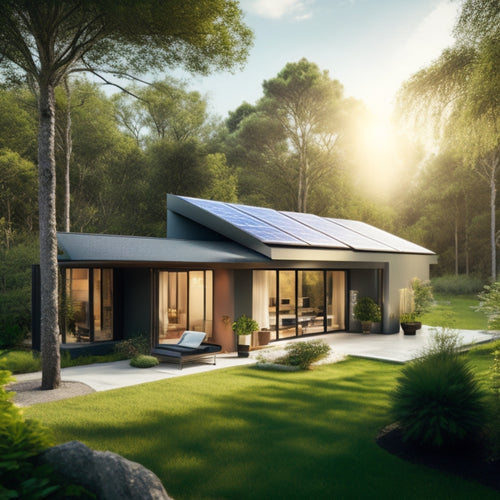
7 Essential Steps for Installing Solar Power Panels at Home
Share
To successfully install solar power panels at home, you'll need to follow seven essential steps. First, determine your energy needs by evaluating your daily consumption and identifying peak usage times. Next, examine your home's suitability by reviewing your roof's size, shape, and orientation, as well as potential shading obstructions. Then, choose the right equipment, considering factors like panel type and warranty. Prepare your roof structure by inspecting for damage and confirming it can support the weight of the panels. Install the panels, guaranteeing secure fastening and ideal positioning. Connect to the grid system, deciding on options like grid-tie with battery storage. Finally, monitor and maintain performance to confirm excellent electricity generation - and that's just the start of your solar-powered expedition.
Key Takeaways
- Assess your home's energy needs by evaluating past electricity bills and identifying peak energy usage times to determine the required solar panel system size.
- Ensure your roof is suitable for solar panels by evaluating its size, shape, orientation, and condition, and addressing any potential obstructions or structural issues.
- Research and comply with local building codes, regulations, and incentives that impact solar panel installation, such as permitted materials and necessary inspections.
- Choose the right solar equipment, including efficient and durable panels, compatible mounting systems, and sufficient warranties, considering your budget and climate.
- Properly install and connect the solar panel system to the grid, ensuring electrical connections meet manufacturer's specifications and local regulations.
Determine Your Energy Needs
With your decision to employ solar power, you're taking the first step towards reducing your carbon footprint and saving on energy bills.
To determine your energy needs, you need to assess your energy consumption patterns. Review your past electricity bills to identify your average daily energy consumption in kilowatt-hours (kWh). This will help you determine the size of the solar panel system you need to install.
Additionally, consider your energy usage patterns, such as the time of day you use the most energy and the appliances that consume the most power. This information will allow you to design a solar panel system that meets your specific energy needs.
Don't forget to factor in the solar incentives available in your area, such as tax credits or rebates, which can greatly reduce the upfront cost of installation.
Assess Your Home's Suitability
You'll need to assess your home's suitability for solar power by evaluating your roof's size and shape, ensuring it can accommodate the required number of panels.
Additionally, you'll need to take into account local building codes and regulations that may impact your installation.
Roof Size and Shape
Across your roof, a patchwork of shingles, tiles, or metals stretches out, presenting a unique canvas for solar power panels. As you contemplate installing solar power, it's crucial to assess your roof's size and shape to guarantee it can accommodate the panels efficiently.
You'll need to evaluate your roof's orientation, which affects the amount of sunlight it receives. A south-facing roof is ideal, but east- and west-facing roofs can also work well. Avoid north-facing roofs, as they receive minimal sunlight.
-
Conduct a shading analysis to identify any obstructions, such as trees, chimneys, or neighboring buildings, that could block sunlight and reduce energy production.
-
Measure your roof's size to determine the number of panels you can fit. A larger roof doesn't always mean more panels, as you'll need to take into account the roof's shape and any obstructions.
-
Reflect on the roof's age and condition, as you may need to replace it before installing solar panels.
Local Building Codes
Before installing solar power panels, it's vital to determine if your home complies with local building codes and regulations. These codes vary by region, so it's important to research and understand the specific requirements for your area. Failing to comply can result in costly rework, fines, or even removal of the solar panel system.
To guarantee compliance, you'll need to verify the following:
| Code Requirement | Description |
| Permitted Materials | Verify that the solar panels and mounting hardware meet local building codes and are approved for use in your area. |
| Inspection Requirements | Determine the necessary inspections and approvals required before and after installation. |
| Electrical Connections | Confirm that the electrical connections meet local codes and are installed correctly. |
| Structural Integrity | Verify that your roof can support the weight of the solar panels and withstand environmental stresses. |
| Zoning and Land Use | Check if there are any zoning or land-use restrictions that may impact your solar panel installation. |
Choose the Right Equipment
Your solar power system's performance hinges on selecting the right equipment. You'll need to choose solar panels, an inverter, and a mounting system that meet your energy needs and fit your budget.
When selecting solar panels, consider the type: monocrystalline, polycrystalline, or thin-film. Each has its own efficiency rates, durability, and cost. Monocrystalline panels are the most efficient but also the most expensive.
-
Research equipment warranties: Look for manufacturers that offer at least a 25-year warranty on solar panels and a 10-year warranty on inverters.
-
Compare the efficiency rates of different solar panel types to determine which one is best for your climate and energy needs.
-
Check the compatibility of the mounting system with your roof type and local building codes.
Prepare Your Roof Structure
Now that you've selected the right equipment for your solar power system, it's time to confirm your roof structure can support it. Before installing solar panels, you need to verify your roof is strong enough to hold the additional weight and withstand various weather conditions. Start by conducting a thorough roof inspection to identify any potential issues, such as damaged or missing shingles, curled or buckled shingles, or signs of wear around chimneys, vents, or skylights.
| Roof Feature | Inspection Criteria | Action Required |
|---|---|---|
| Shingles | Damaged, missing, curled, or buckled | Replace or repair damaged shingles |
| Flashing | Loose, damaged, or missing | Re-attach or replace flashing |
| Chimneys/Vents | Cracked, damaged, or obstructed | Repair or clear obstructions |
| Skylights | Cracked, damaged, or leaking | Repair or replace skylights |
| Roof Age | Older than 10 years | Consider replacing the entire roof |
If your roof inspection reveals any issues, you may need to perform structural reinforcement, such as adding additional supports or replacing rotten wood, to confirm your roof can safely support the weight of the solar panels. This step is vital to prevent damage to your roof or solar panels and to guarantee a safe and efficient energy-generating system.
Install the Solar Panels
The solar panel installation process begins with carefully transporting the panels to the roof.
You'll want to guarantee that the panels are securely fastened to the roof to withstand various weather conditions. The type of solar panel you've chosen will also impact the installation process. For instance, thin-film solar panels are more flexible and lighter than traditional crystalline silicon panels, making them easier to handle.
When installing the panels, consider the following:
-
Verify the panel's electrical connections: Confirm that the connections are secure and meet the manufacturer's specifications to avoid electrical shock or fire hazards.
-
Position the panels for peak energy harvesting: Carefully angle and orient the panels to maximize energy production, considering shading, roof orientation, and local building codes.
-
Comply with local building codes and regulations: Familiarize yourself with local permits, inspections, and installation costs to avoid costly rework or penalties.
Connect to the Grid System
You've installed your solar panels, and now it's time to connect them to the grid system.
You'll need to decide on a grid connection option that suits your needs, considering factors like energy storage and backup power.
Grid Connection Options
Your rooftop solar array is ready to shine, but it's only half the battle - you need to connect it to the grid system to offset your electricity bills and even sell excess energy back to the utility company.
When connecting to the grid, you have a few options to evaluate.
-
Grid-Tie System: This is the most common connection type, where your solar array feeds excess energy back into the grid and you receive credits on your electricity bill. This option is ideal for homeowners who want to offset their electricity costs and don't need backup power during outages.
-
Grid-Tie with Battery Storage: This system allows you to store excess energy in batteries for later use, providing backup power during outages. This option is suitable for homeowners who want to guarantee a steady supply of power, even when the grid is down.
-
Off-Grid Systems: If you're not connected to the grid at all, you'll need a standalone off-grid system that stores excess energy in batteries for later use. This option is ideal for remote locations or areas with frequent power outages.
Remember to consult with a licensed electrician to determine the best grid connection option for your solar power system.
Net Metering Benefits
With your rooftop solar array connected to the grid system, you're ready to reap the benefits of net metering, a policy that allows homeowners like you to offset their electricity bills and even generate revenue by selling excess energy back to the utility company.
This means you'll only pay for the electricity you use beyond what your solar panel system produces. By doing so, you'll enjoy significant cost savings, as you'll be reducing your reliance on the grid and lowering your energy expenses.
Moreover, net metering allows you to contribute to a cleaner environment by producing clean energy and reducing your carbon footprint.
The environmental impact of solar power is substantial, and by utilizing this renewable energy source, you'll be doing your part to combat climate change.
As you generate excess energy, you'll be credited for it and can use those credits to offset your energy consumption during periods of low sunlight or at night.
This setup guarantees that you're maximizing your energy independence while minimizing your environmental impact.
Utility Company Approval
Interconnection agreements are the linchpin of grid-connected solar power systems, as they formally establish the terms of your partnership with the utility company.
To obtain utility company approval, you'll need to submit an application, which typically includes details about your solar power system, such as its size, type, and installation location. You'll also need to provide documentation, like your system's certification and electrical diagrams.
-
Review and understand the utility company's interconnection agreements and utility regulations to guarantee compliance.
-
Ascertain your solar power system meets the utility company's technical requirements, including voltage, frequency, and power quality standards.
-
Prepare for and pass a safety inspection by the utility company, which may include a review of your system's electrical connections and grounding.
Monitor and Maintain Performance
Regularly, you'll need to check your solar power system's performance to verify it's generating electricity at ideal levels. This involves system monitoring, which helps identify potential issues before they escalate into major problems.
Invest in a monitoring system that provides real-time data on your energy production, allowing you to track your system's performance and optimize its output.
Performance optimization is essential to guarantee you're getting the most out of your solar power system. By analyzing the data, you can identify areas for improvement, such as cleaning the panels or adjusting the angle of the array.
This proactive approach enables you to address minor issues before they impact your energy production. Additionally, many monitoring systems offer alerts and notifications, so you can stay on top of your system's performance and respond quickly to any issues that arise.
Frequently Asked Questions
Do Solar Panels Work During Power Outages?
You're wondering if solar panels work during power outages - the answer is, it depends. If you have a grid-tied system, you'll lose power, but with a solar battery, you can store excess energy and keep the lights on during an outage.
Can I Install Solar Panels Myself?
If you think you can DIY, remember: 'jack of all trades, expert of none.' While possible, installing solar panels yourself can be complex; without knowledge, you might void warranties or sacrifice efficiency. Consider hiring a pro for a safe, ideal DIY solar system installation.
How Long Do Solar Panels Last?
You'll be pleased to know that solar panels can last up to 30 years or more, depending on the quality and maintenance requirements, with a typical solar panel lifespan ranging from 25 to 30 years with minimal degradation.
Do Solar Panels Increase Property Value?
You'll likely enhance your property value by installing solar panels, just like a fresh coat of paint; in fact, a study shows that solar panels can elevate your home's value by up to $15,000 through increased energy savings from your solar investment.
Can I Add More Panels Later?
You can easily add more panels later, thanks to future expansion capabilities built into modern systems, ensuring system compatibility and seamless integration, so you can increase your energy output as your power needs grow.
Conclusion
You've successfully installed solar power panels at home! Now, capture the energy of the sun to reduce your carbon footprint and save on electricity bills. Did you know that a typical residential solar panel system can save homeowners between $400 and $1,000 per year on their electricity bills? With solar power, you're not only contributing to a sustainable future but also making a smart investment.
Related Posts
-

Top-Rated Solar Storage Solutions for Homeowners
When considering top-rated solar storage solutions, you're looking at systems that provide energy independence and si...
-

High-Performance Energy-Efficient HVAC Systems
High-performance energy-efficient HVAC systems are essential for reducing energy consumption while improving indoor c...
-

How to Reduce Home Energy Bills
To reduce your home energy bills, start by investing in energy-efficient appliances and upgrading your insulation. Lo...


